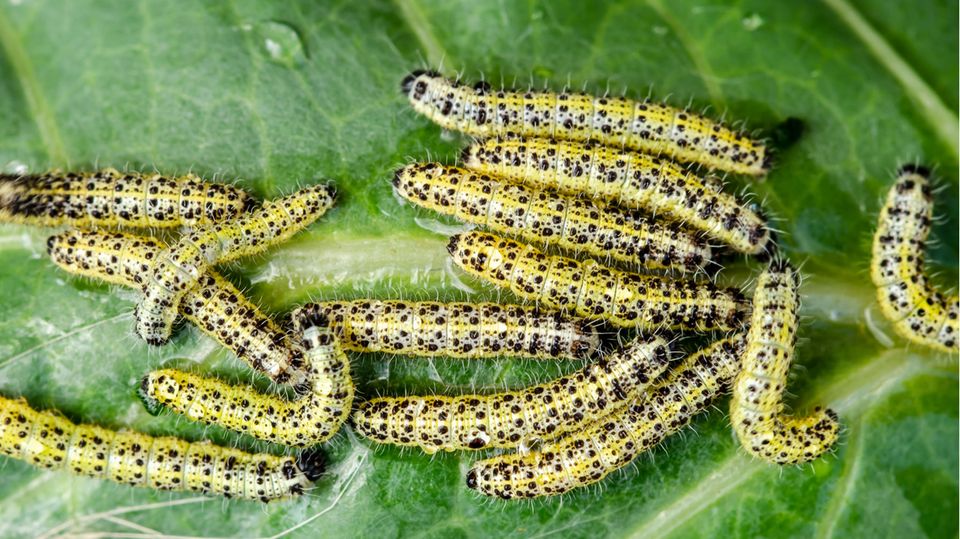Cabbage white butterfly
Butterfly caterpillars in the vegetable patch? How to protect your cabbage varieties
A seemingly harmless butterfly that targets your vegetables: the cabbage white butterfly
© Milanika/Getty Images
It’s hard to believe that a butterfly can cause so much damage: the offspring of the cabbage white butterfly have an insatiable appetite for cauliflower and kohlrabi, savoy cabbage and white cabbage. If you don’t do anything about the infestation, at the end of every feeding spree there will only be bare leaf veins left in the vegetable patch.
The cabbage white butterfly is a beautiful butterfly that is active during the day. In spring the butterfly looks for suitable plants on which its offspring can feast. All types of cabbage are on their menu, but the caterpillars also do not disdain rapeseed, field mustard or rocket. Between June and October the big eating begins – in the truest sense of the word. There are various options to counteract an acute infestation. What these are and how you can preventively keep the cabbage white butterfly out of your vegetable beds is explained below.
Recognize large and small cabbage white butterflies
Basically, a distinction must be made between the large and the small cabbage white butterfly. You can tell which vegetable pest is in your garden by the following signs:
Large Cabbage White
From a purely visual point of view, both butterflies look very similar. However, this does not apply to their offspring: the caterpillars of the large cabbage white butterfly (Pieris brassicae) are yellowish-green and have black spots. The biggest difference, however, lies in their feeding behavior, as in this case the pests “only” eat the leaves of vegetable plants down to their skeletons.
Little Cabbage White
The caterpillars of the small cabbage white butterfly (Pieris rapae) are much more widespread, have a green coat and usually occur singly and not in large numbers like their “larger” relatives. Nevertheless, they cause much more damage because the pests eat their way into the hearts of the cabbages and the plant can die completely.
Fighting cabbage white butterfly biologically: this is how it works The caterpillars of the greater cabbage white butterfly eat their fill of the vegetable leaves © Imagesines / Getty Images
To combat the large or small cabbage white butterfly in a natural way – without the use of chemicals – you can use beneficial insects: such as parasitic wasps of the genus Trichogramma. They lay their eggs in those of the butterflies so that their offspring eat the caterpillars. If there are no more eggs, the little flies disappear on their own. This special type of parasitic wasp is available on a few platforms on the Internet, but not in large online shops such as Amazon.
A notice: There is still a downside: If you use the parasitic wasps outdoors, there is a chance that the small flies will be “lost” – be it by birds, for whom they serve as a food source, or by strong gusts of wind. Accordingly, the use of parasitic wasps against cabbage white butterflies in the greenhouse is much more effective.
Another way to protect your plants from the pest is Legona borer-free XenTari: The biological control agent contains the strain of Bacillus thuriengiensis and is used against the infestation of borers, cabbage white butterflies and frostbite moths. Proceed as follows:
- Measure the required amount according to the desired application area. A suitable measuring spoon is included with the product.
- Pour the measured amount of control agent into one spray bottle and dissolve the powder in water while stirring.
- Wet all affected areas with the spray liquid. As soon as the leaves are eaten, eating stops immediately.
This is how you prevent cabbage white butterflies in the long term
To prevent cabbage white butterfly caterpillars from eating your cabbage leaves or other vegetable plants, you can take preventive measures:
- Be on the lookout for butterflies in spring. As soon as you spot them near your vegetable beds, you can check the undersides of the leaves for the butterflies’ yellow eggs. If you have discovered a nest, you can collect the eggs by hand (wearing gloves) and dispose of them. If the first caterpillars are already found on your cabbage varieties, you can also collect them by hand.
- Supposedly, strongly scented plants – such as thyme or anise, sage or mint – are supposed to ensure that cabbage white butterflies run away. Simply place these plants between the cabbage varieties. Alternatively, a plant decoction made from tansy or wormwood can also help as a deterrent if you water the cabbage with it.
- Since the caterpillars are on the menu of some birds (unfortunately they are inedible for many animals), you can take measures to attract the natural predators into your garden – for example by setting up a bird bath or hanging up nesting boxes.
- Place fresh tomato leaves around the cabbage; the strong smell is said to mislead the butterflies. The same effect can probably also be achieved with mixed cultures.
- Bring around the cabbage seedlings fine-meshed protective nets through which the butterfly cannot fly.
Sources: NABU, my beautiful garden
You might also be interested in:
This article contains so-called affiliate links. Further information are available here.



